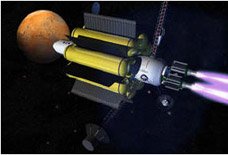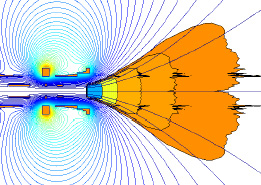|
NASA
scientists are currently developing new rocket engine technology
that could seriously
reduce the time of a mission to Mars. This new technology is
called a Variable
Specific Impulse Magnetoplasm Rocket (VASIMR).

Artist's rendition of a spacecraft
powered by multiple VASIMR engines, from:
http://www.nasa.gov/vision/space/travelinginspace/future_propulsion.html
The VASIMR utilizes radio waves to ionize and
superheat a propellant, converting it to plasma. This plasma is
then directed and accelerated by a powerful magnetic field, resulting
in thrust.
This image gives a basic
schematic of the VASIMR. Propellant (argon gas) is fed into radio
antennas which convert it to plasma. The plasma is then
accelerated via superconducting magnetic coils, and a radio frequency
booster antenna.
|

Image courtesy
of NASA:
http://spaceflight.nasa.gov/shuttle/support/researching/aspl/images/vasimr2_new_large.gif
|

Image courtesy
of NASA: http://www.nasa.gov/vision/space/travelinginspace/future_propulsion.html
|
This image depicts the strong
magnetic field which directs, accelerates, and contains the
plasma. Plasma reaches temperatures as high as 1,000,000°
C. This is far hotter than any metal can withstand. The
magnetic field contains the plasma and prevents it from overheating the
VASIMR.
|
New Horizons
The VASIMR runs on
electricity. In nearby applications solar panels can be used to
power it. For missions into deeper space, nuclear reactors would
be needed. While the VASIMR doesn't have a high enough
thrust/weight ratio for escaping Earth's gravity, it could be
implemented to speed up round trip Mars missions to as little as 5
months. In addition, it offers some limited abort options which
the traditional "fire and coast" method of space travel does not.
While it's true that it does have its detractors,
VASIMR and other similar projects seem to be the wave of the future,
and seem to offer new options for exploring our nearest planetary
neighbor.
Bibliography
|


